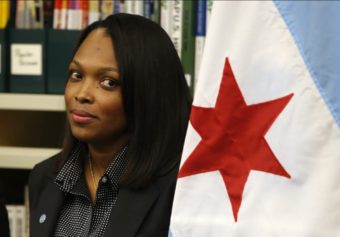More than 100 demonstrators in Chicago were arrested among thousands of protesters Wednesday in a planned civil disobedience to object to the closing of 54 schools in the nation’s third-largest school district.
The massive protest served as a piercing message to Mayor Rahm Emanuel that his decision will face aggressive resistance.
“We’re signalling that there is going to be a large and determined movement that will use the tactics of civil disobedience and direct action in order to keep these schools open,” said Chicago Teachers Union vice-president Jesse Sharkey, who was arrested outside City Hall, one of 131 detained by police. “We see this event as kicking off an extended campaign this spring and we think it was a great success.”
The planned closings, perhaps the largest number school closings in U.S. history, will affect more than 30,000 students, primarily in low-income black and Latino neighborhoods. Emanuel and schools chief Barbara Byrd-Bennett have said the closures are necessary because the school system faces a $1 billion budget shortfall and has too many schools that are half-empty and failing academically. The city hopes to save $560 million over 10 years in capital costs and $43 million per year in operating costs.
In many cases, the schools were built to accommodate the populations at the large public housing projects that have been torn down in recent years, leaving schools severely underutilized. But observers are worried that the dislocation from the closings will lead to more violence and murder, as students who are gang members will be forced to travel into areas controlled by rival gangs.
This has been one of the under-reported stories in the current spate of violence rocking the city—an endless round of retaliation shootings that have come as a result of the city closing about 100 schools over the past decade.
Though the district insists the savings will go to improving classroom resources, including air conditioning, libraries and iPads for all students in grades 3-8, a study by a well-respected Chicago education advocacy group has questioned whether improved student outcomes will result.
The University of Chicago’s Consortium on Chicago School Research released a study revealing that of the 38 schools closed between 2001 and 2006, only 6% of students who were moved went to high-performing schools.
In addition, Emily Dowdall, a senior associate at the Pew Charitable Trusts, told the New York Times, “Our research found that school districts tended to save under $1 million per school [closed],” she said. “So in some ways, that’s not a game-changing amount.”
Sharkey said the city rarely follows through on its promises on savings. “In the past there’s been investment for the first one or two years,” Sharkey said. “But the money dries up once the attention is gone.”
At the rally, Chicago Teachers Union President Karen Lewis, who tangled with Mayor Emanuel last year when the teachers went on strike, said, “People have a right to the neighborhoods in which they live. Children have the right to a safe, nurturing, loving environment.”
Of the 100 schools closed since 2001, 80 percent of the students affected in those closings were black, even though black students comprise just over 40 percent of the city’s student body as a whole.
“For too long children in certain parts of Chicago have been cheated out of the resources they need to succeed because they are in underutilized, under-resourced schools,” said Barbara Byrd-Bennett, the CPS chief executive, explaining the announcement. “The district must consolidate . . . to get students into higher-performing schools.”
Emmanuel justified the closings by saying it was for the children.
“If we don’t make these changes we haven’t lived up to our responsibility as adults to the children of the city of Chicago,” he said. “And I did not run for office to shirk my responsibility.”


